Bibimbap Recipe: Korean Mixed Rice Bowl
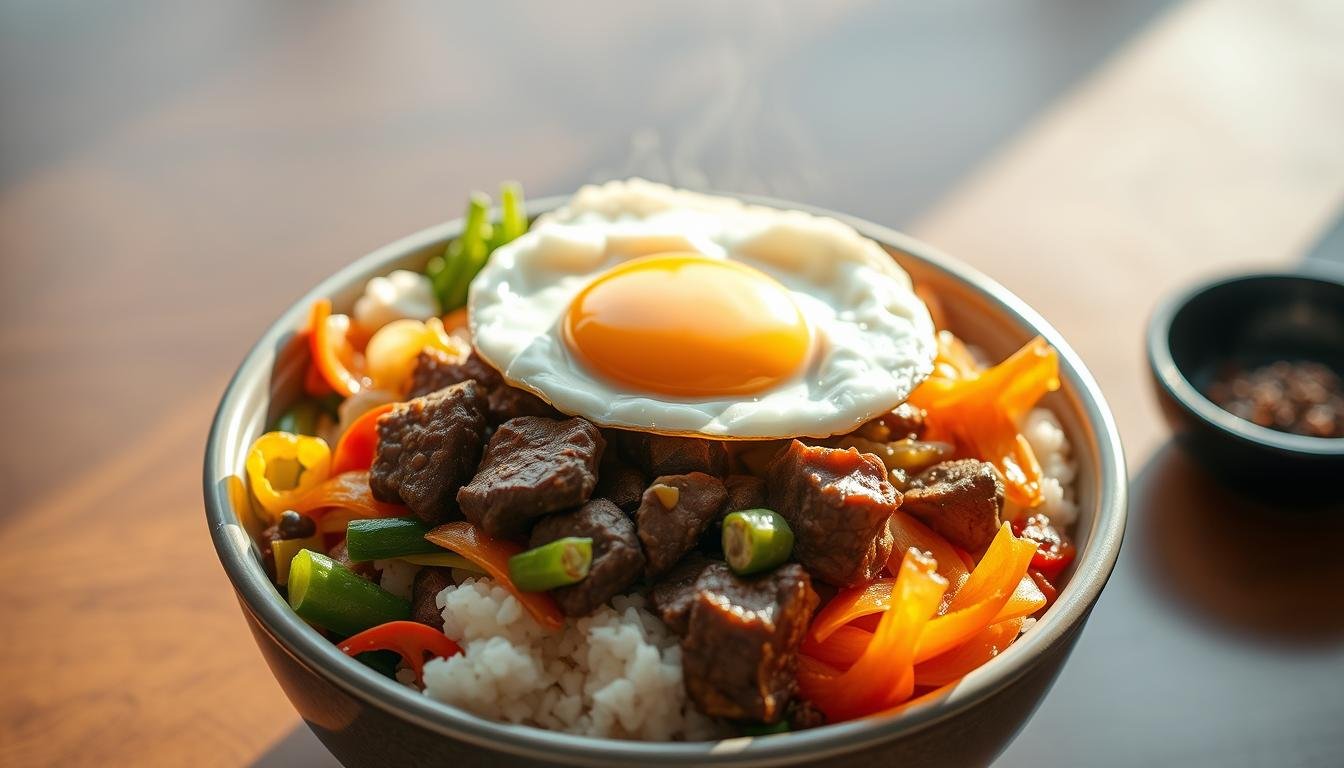
Have you ever wondered how a single bowl of food can deliver a symphony of flavors and textures? Welcome to the world of bibimbap—a beloved Korean mixed rice dish. It harmonizes vibrant vegetables, tender proteins, and a spicy sauce.
Bibimbap, which translates to “mixed rice,” invites you to experiment by mixing and matching ingredients. This dish has deep-rooted origins in Korean culture. It offers an array of variations, ensuring there’s something for everyone at your dining table.
What is Bibimbap?
Bibimbap is a favorite dish in Korean food. It’s more than food; it’s a piece of history and culture. It has steamed rice, colorful veggies, and sometimes meat or an egg.
It started with leftovers. Now, it has many versions for different tastes and places.
The Origins of Bibimbap
Bibimbap’s history goes back to the late Joseon Dynasty. The first records were in the 16th century, thanks to Bak Dongnyang. In the 19th century, a secret cookbook shared the first bibimbap recipe.
Farmers loved it for its easy making. It’s a mix of foods, from special *Goldongban* to today’s versions.
Different Variations of Bibimbap
There are many bibimbap types, each with its own twist. Dolsot bibimbap is served in a hot stone pot. This makes the rice crispy at the bottom.
Other types include:
- Jeonju bibimbap: A famous dish from Jeonju, celebrated at a festival.
- Hoedeopbap: Has raw seafood, loved by the coast.
- Yakcho-bibimbap: Adds medicinal herbs from Jecheon, boosting health.
Bibimbap changes with the seasons. Each bowl is a feast of flavors, colors, and textures.

Essential Ingredients for Bibimbap
Bibimbap is a mix of flavors and textures. It has rice, vegetables, and proteins. These ingredients make a healthy and balanced meal.
Rice: The Foundation of the Dish
Short-grain white rice is at the heart of bibimbap. It’s sticky and holds the ingredients well. You need 4 cups of cooked rice for four people.
Common Vegetables Used
Vegetables are key in bibimbap. They include:
- Sautéed spinach
- Bean sprouts (4 cups recommended)
- Shredded carrots (1 large carrot)
- Shiitake mushrooms (8 large dried ones)
- Zucchini (1 large zucchini)
- Red bell pepper (1 large bell pepper)
- English cucumber (1)
- Green onions (3 to 4)
These veggies add color and nutrients to your bibimbap.
Proteins: Tofu, Beef, and More
Proteins in bibimbap are versatile. You can choose:
- Marinated beef (recommended amount of ½ pound)
- Firm tofu, prepared to suit your taste
- Seafood, such as shrimp or fish
Combining proteins makes the dish richer. Each ingredient is important for a nutritious meal.
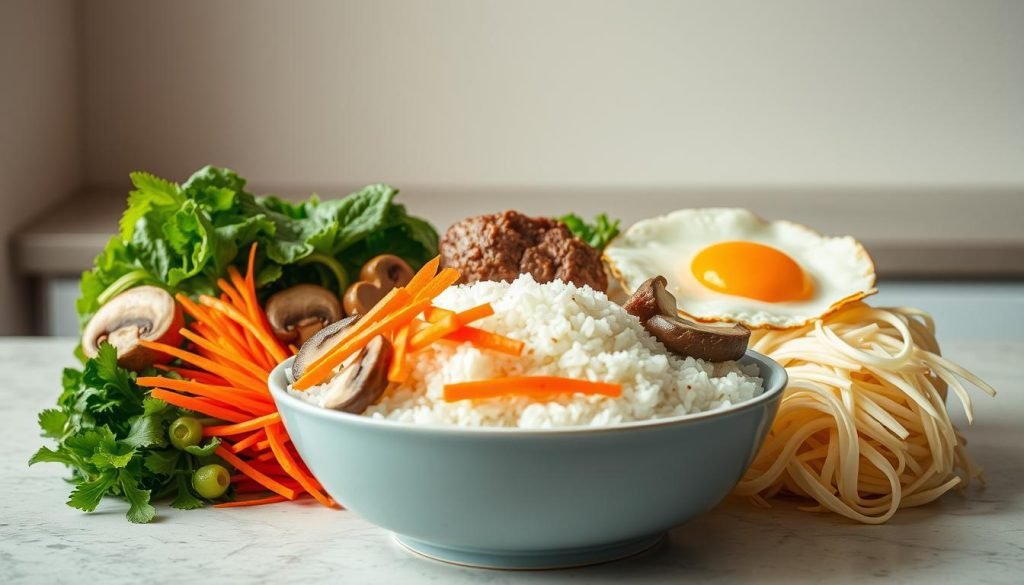
| Ingredient | Amount |
|---|---|
| Cooked short-grain rice | 4 cups |
| Sautéed spinach | 8 ounces |
| Bean sprouts | 4 cups |
| Carrot | 1 large |
| Shiitake mushrooms | 8 large dried |
| Zucchini | 1 large |
| Red bell pepper | 1 large |
| Green onions | 3 to 4 |
| Beef | ½ pound |
How to Prepare the Perfect Rice
Getting the perfect rice is key for bibimbap. This Korean dish needs rice that’s just right. It should be sticky and match the dish’s bright flavors.
Short-grain rice is best for bibimbap. It’s sticky, making it easy to eat with chopsticks. We’ll show you the best rice types and how to cook it fluffy.
Types of Rice: Which is Best for Bibimbap?
For bibimbap, you can choose from a few rice types. Short-grain white rice is the most popular. It’s sticky and perfect for eating with chopsticks.
Brown rice is a healthier choice. It adds a nutty taste. Cauliflower rice is low in carbs for those watching their calories. Pick the rice that tastes best to you.
Cooking Techniques for Fluffy Rice
Using the right cooking methods makes rice fluffy. First, rinse the rice to remove excess starch. This stops it from clumping.
Soak the rice in water for 30 minutes. This makes it even better. Cook it gently to avoid burning. A rice cooker makes it easy.
If you cook on the stovetop, watch the water. The right rice makes your bibimbap even better.
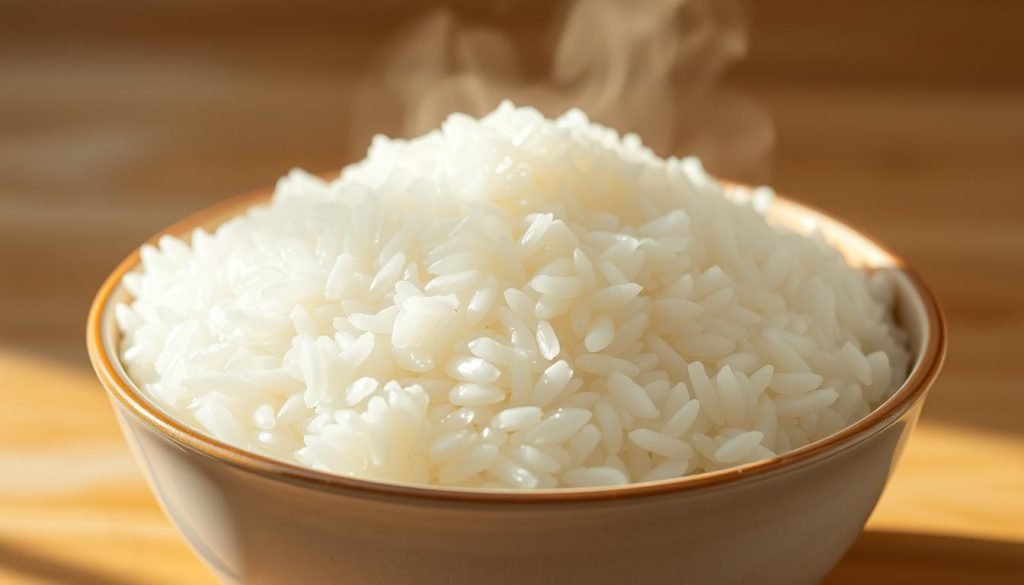
Preparing the Vegetables
Getting your veggies ready is key to making great bibimbap. It makes the dish look and taste better. Each veggie needs a special way to cook to keep it fresh and colorful.
Common Cooking Methods
There are many ways to cook veggies in Korean dishes. Here are some top methods:
- Sautéing: Perfect for carrots and zucchini. It makes them taste better and stay crunchy. Cooking time is 1 to 2 minutes.
- Steaming: Best for spinach and other greens. It cooks them fast, in about 30 seconds.
- Blanching: Ideal for soybean sprouts. It cooks them in boiling water for 1 minute, then cools them quickly to keep them crisp.
Seasonal Vegetable Suggestions
Using veggies in season adds flavor and helps the planet. Here are some great choices for your bibimbap:
| Vegetable | Season | Nutritional Benefits |
|---|---|---|
| Spinach | Spring | High in iron and vitamins A and C |
| Carrots | Year-round | Rich in beta-carotene and fiber |
| Zucchini | Summer | Low in calories, high in vitamin C |
| Bean Sprouts | Spring | Excellent source of vitamins and minerals |
| Bell Peppers | Summer | High in antioxidants, supports immune health |

Protein Options for Your Bibimbap
Bibimbap has many protein choices, just like the colorful veggies it comes with. You can pick beef or try other tasty options. This lets you make your dish just how you like it.
How to Cook Beef to Perfection
For beef in bibimbap, try marinated beef bulgogi. The marinade has soy sauce, garlic, and a bit of sweetness. Cook it to 145°F for 5-7 minutes. This makes the beef juicy and full of flavor.
Tofu and Its Flavor Possibilities
Tofu is great for those who don’t eat meat. Grill or sauté it to soak up tasty sauces. Use gochujang or soy sauce for extra flavor. Tofu fits well with bibimbap’s other ingredients, making it just as good without meat.
Incorporating Seafood
Seafood like shrimp or fish adds a special touch to bibimbap. Just sauté it until it’s done, then season with garlic and light sauces. Seafood brings variety and a great taste that goes well with rice and veggies.
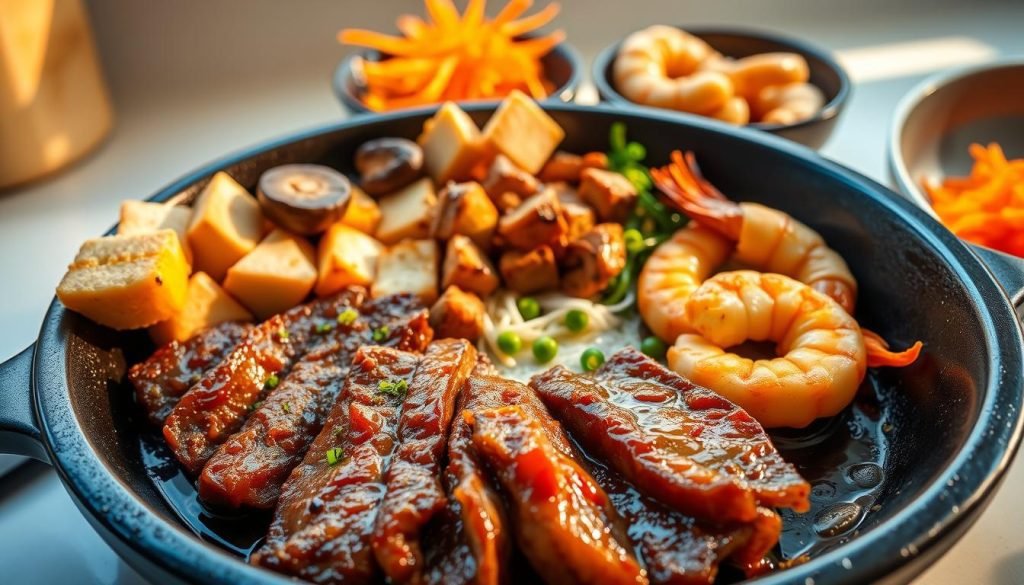
| Protein Option | Preparation Method | Flavor Enhancements |
|---|---|---|
| Beef | Sautéed or grilled | Marinated with soy sauce, garlic, and seasonal ingredients |
| Tofu | Grilled or sautéed | Pai with gochujang or soy sauce |
| Seafood | Sautéed | Seasoned with garlic and light sauces |
Trying different proteins makes bibimbap your own. It lets you enjoy a classic dish in your own way.
Making the Sauce: Gochujang and Beyond
The bibimbap sauce is key for flavor in your Korean mixed rice bowl. At its heart is gochujang, a chili paste. It adds spice and sweetness, making your bibimbap taste great.
What is Gochujang?
Gochujang is a big deal in Korean food. It has a deep, umami taste and is quite spicy. It takes six months to ferment, making it full of flavor.
Real gochujang is made from chili powder, soybean powder, and rice. It can be very spicy, from 300 to over 2000 SHU. But, many store-bought versions have corn syrup, which isn’t as good.
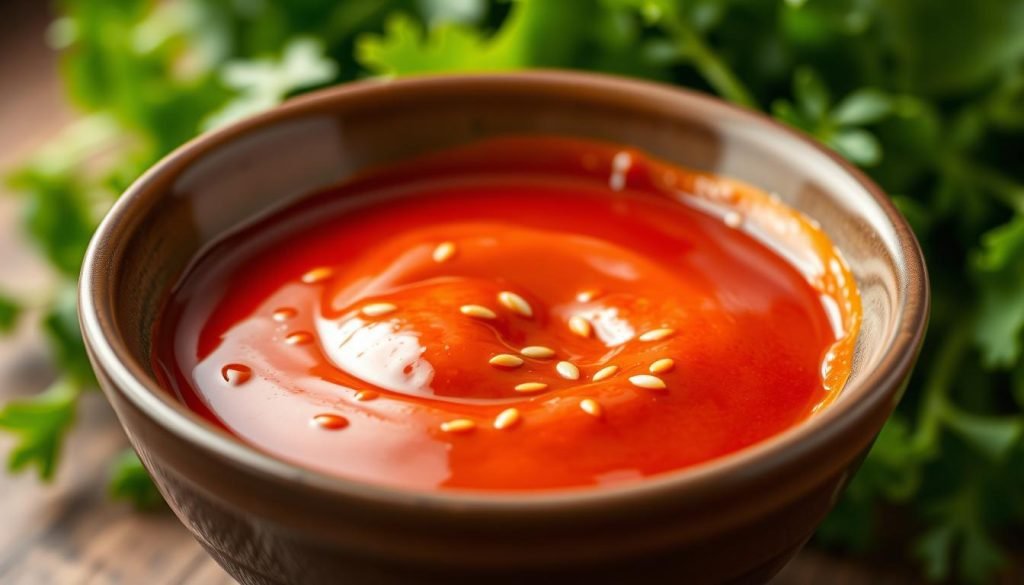
Alternative Sauces for Bibimbap
Want something milder? Try a sauce with soy sauce, sesame oil, and vinegar. It’s tasty and suits many tastes. For more heat, mix gochujang with honey. A little honey makes it spicier, while more makes it milder.
- Main ingredients for a stir-fried gochujang sauce:
- 200g (7 ounces) of minced beef or pork
- 3/4 cup of gochujang
- 3 tablespoons of water
- Honey, adjusted from 1 teaspoon to 1 tablespoon
This sauce recipe makes 15 bibimbap bowls, great for sharing or prep. Keep leftovers in the fridge for up to 10 days. Start making your own bibimbap sauce today! Enjoy exploring spicy Korean food with every bowl.
Assembling Your Bibimbap Bowl
Assembling bibimbap is fun. You’ll layer ingredients for great taste and look. Start with rice in the bowl. This is the base.
Then, add vegetables and proteins on top. Try to mix colors and textures. This makes the dish look good and taste great.
Layering Ingredients for Balance
For a balanced bibimbap, use these parts:
- Rice: Use about 1 1/4 cups of cooked short-grain rice per serving.
- Vegetables: Pick at least four types like Korean cucumber, carrots, zucchini, and shiitake mushrooms.
- Protein: Choose marinated beef, tofu, or seafood for extra flavor.
- Sauce: Drizzle gochujang and sesame oil on top for more taste.
After layering, make it look good. Assembling bibimbap lets you be creative. You can mix veggies or fry them separately.
Tips for Serving
Use pretty bowls to serve bibimbap. It makes eating more fun. Also, have gochujang and sesame oil ready for guests to add more flavor.
Traditionally, bibimbap is best at room temperature. But serving it hot is exciting too.
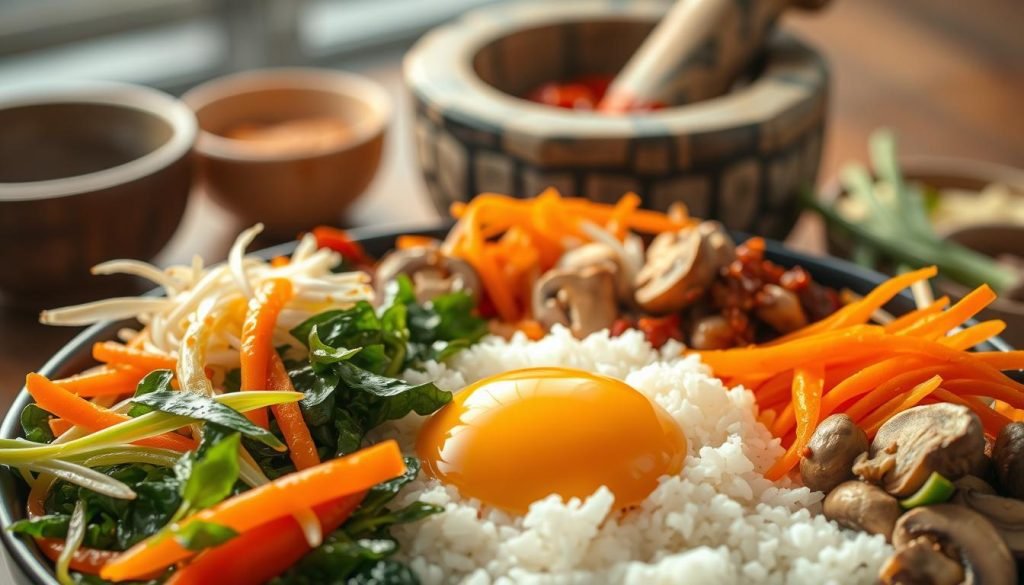
Nutritional Benefits of Bibimbap
Bibimbap is a tasty and healthy dish. It mixes many ingredients into a balanced meal. This Korean mixed rice bowl is not just yummy but also good for you.
It has lots of veggies, proteins, and healthy fats. So, you get a big meal that helps you stay healthy.
A Balanced Meal in One Bowl
One bowl of bibimbap has lots of nutrients. It has a mix of veggies, proteins, and healthy fats. This makes it a full meal that’s good for you.
The fiber, protein, and healthy fats in bibimbap make you feel full. You’ll be happy and satisfied.
Health Benefits of Key Ingredients
The ingredients in bibimbap are good for you. Here are some benefits:
- Vegetables: Leafy greens like spinach have vitamins A and C. They help keep your immune system strong. Carrots add more antioxidants.
- Proteins: Tofu or beef in bibimbap helps muscles repair. It keeps your body working well.
- Whole grains: The rice base gives you carbs. It gives you energy all day.
- Healthy fats: Sesame oil adds flavor and healthy fats to your meal.
Bibimbap is a great choice for a healthy meal. It’s also perfect if you just want something tasty.
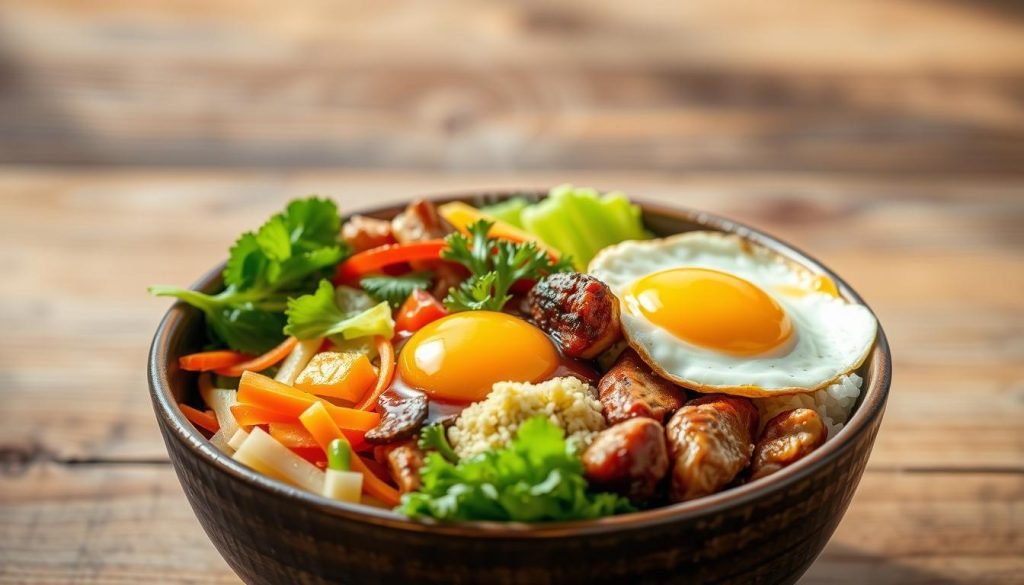
Tips for Customizing Your Bibimbap
Bibimbap is super flexible. You can make it your own with special ingredients. Try adding exotic mushrooms, fresh herbs, or different proteins. This way, you can make a bowl that you love.
When you customize bibimbap, you get to choose. Pick your favorite veggies, proteins, and sauces. It’s all about what you like best.
Personalizing with Unique Ingredients
Knowing how to mix flavors is key. Try pairing savory with spicy or sweet. This makes your bibimbap special.
It’s also great for different diets. You can make it vegan or add more protein. Use fresh veggies or try new ones like asparagus or spinach.
Understanding Flavor Combinations
When you make bibimbap your own, think about how ingredients work together. Pickled veggies add a nice crunch. They go well with creamy eggs or rich meat.
Try mixing different tastes for a great bowl. Crunchy, savory, and spicy are all good. So, be creative and enjoy every bite!